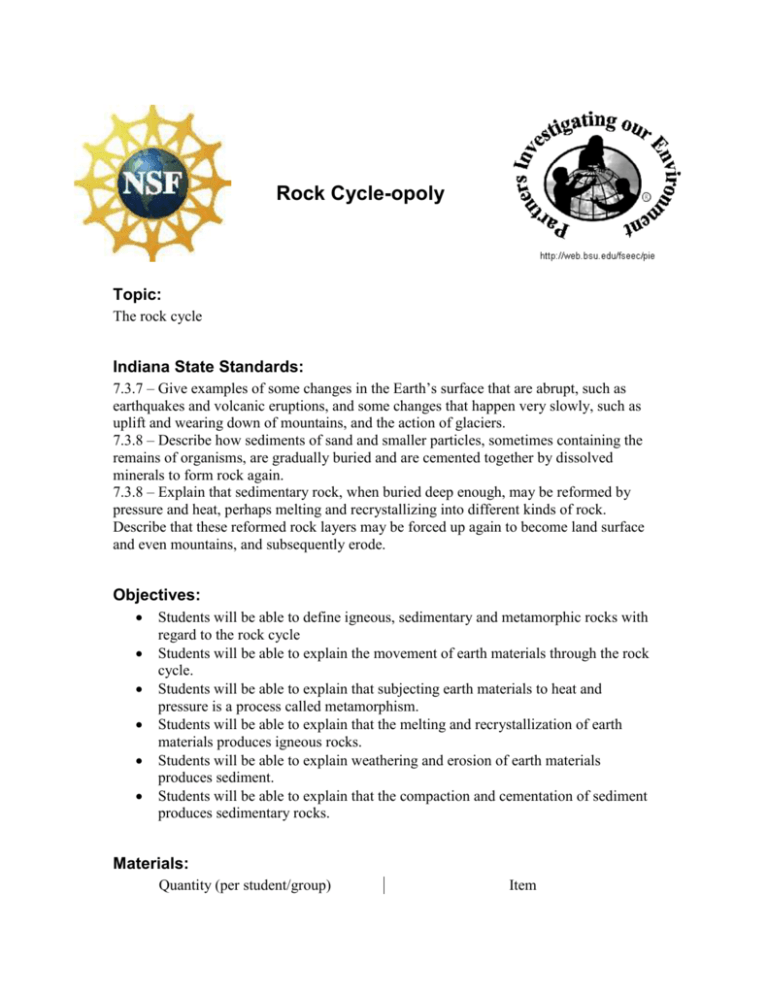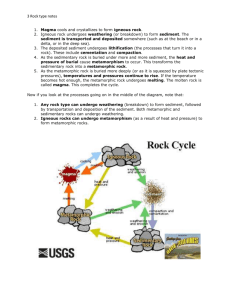Rock Cycle
advertisement

Rock Cycle-opoly Topic: The rock cycle Indiana State Standards: 7.3.7 – Give examples of some changes in the Earth’s surface that are abrupt, such as earthquakes and volcanic eruptions, and some changes that happen very slowly, such as uplift and wearing down of mountains, and the action of glaciers. 7.3.8 – Describe how sediments of sand and smaller particles, sometimes containing the remains of organisms, are gradually buried and are cemented together by dissolved minerals to form rock again. 7.3.8 – Explain that sedimentary rock, when buried deep enough, may be reformed by pressure and heat, perhaps melting and recrystallizing into different kinds of rock. Describe that these reformed rock layers may be forced up again to become land surface and even mountains, and subsequently erode. Objectives: Students will be able to define igneous, sedimentary and metamorphic rocks with regard to the rock cycle Students will be able to explain the movement of earth materials through the rock cycle. Students will be able to explain that subjecting earth materials to heat and pressure is a process called metamorphism. Students will be able to explain that the melting and recrystallization of earth materials produces igneous rocks. Students will be able to explain weathering and erosion of earth materials produces sediment. Students will be able to explain that the compaction and cementation of sediment produces sedimentary rocks. Materials: Quantity (per student/group) Item 1 1 1 1 Rock Cycle Sheet Instruction Sheet Dice End of activity questions Lesson background: The continuous process where rocks change from one of three types to another is known as the rock cycle. The changes from one type to another can take many different paths. Procedure: 1. Divide the students into appropriate groups 2. This activity assumes that students have had a brief introduction to the rock cycle. If not, the following sequence might be helpful. a. Ask students if they think rocks can change. Hand out a copy of the rock cycle. b. Explain to students the rock cycle is the framework upon which geologists understand how rocks slowly change from one type to another. c. Show students examples of sediment and igneous, sedimentary, and metamorphic rocks. Ask if they can think of any ways to transform one of the samples to another. i. Note: It helps if you use a sedimentary rock with larger clasts. Using sediment of the same size is also quite helpful. ii. It is also sometimes helpful to break a rock into smaller pieces; thus, introducing weathering. 3. Explain to students that they are going to play a game where they will simulate the movement around the rock cycle. 4. Explain the directions to the students. Using a board game analogy is quite useful here. All students start on Magma and progress around the board (rock cycle). Make sure that students are recording their “route” and know to repeat the activity three times. 5. Observe students during the exercise. Answer questions as needed. 6. Have students begin the questions as they finish. Closure: 1. Have students complete the question sheet. 2. Discuss with students why some parts of the rock cycle cannot be observed. Directions: You are a piece of earth material traveling through the rock cycle. Starting from magma, roll the dice to determine your next step. Record your progress in a table for 20 steps. Repeat this again two more times. Location Dice Go to: Magma Even Cooling and solidification Odd Magma (stay where you are) Even Igneous Rock Odd Cooling and Solidification (stay Cooling and solidification where you are) Igneous Weathering Sediment Lithification Sedimentary Rock Metamorphism Metamorphic Rock Melting 1 or 5 Weathering 2 or 6 Metamorphism 3 or 4 Melting Even Sediment Odd Weathering (stay where you are) Even Lithification Odd Sediment (stay where you are) Even Sedimentary Rock Odd Lithification (stay where you are) 1 or 5 Metamorphism 2 or 6 Weathering 3 or 4 Melting Even Metamorphic Rock Odd Metamorphism (stay where you are) 1 or 5 Melting 2 or 6 Weathering 3 or 4 Metamorphism Even Magma Odd Melting (stay where you are) Questions: 1. Where did you spend most of your time? 2. Why is the rock cycle called a cycle? 3. What are the possible directions a sedimentary rock can take in this cycle? 4. Did all of your classmates follow the same path? 5. Does every rock follow the same path in nature? 6. How much of the rock cycle can be observed? How much is inferred? List specific steps in your answer. 7. How might the movement of material through the rock cycle affect people? 8. Assuming that each roll required 200,000 years, determine the average time it took for each of the following steps to occur. Cooling to sediment:________________________ Weathering to Igneous rock:___________________________ Metamorphic rock to weathering:___________________________ Magma Cooling Solidification Melting Melting Metamorphic Rock Igneous Rock Weathering Metamorphism Metamorphism Weathering Weathering Sedimentary Rock Sediment Lithification The Rock Cycle





